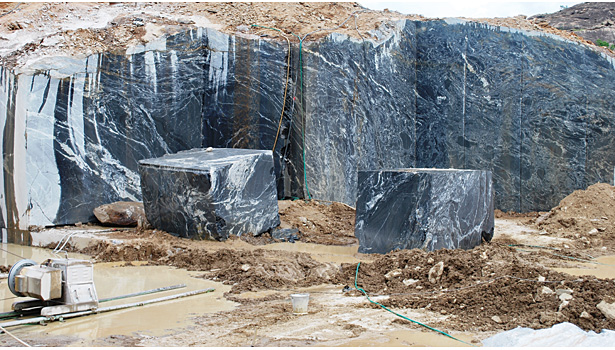Uncovering the Rich History and Lasting Practices of Granite Quarrying
As we depend on the precipice of discovering the detailed tapestry of granite quarrying, a journey with time reveals not simply the physical act of extracting stone but additionally the cultural and historical significance woven right into the really fabric of this method. From the old beginnings that laid the structure for contemporary quarrying techniques to the lasting techniques that are forming the future of this sector, each sculpt mark on granite surface areas tells a tale waiting to be unearthed (granite quarries in south africa). The heritage of granite quarrying stretches much beyond plain extraction; it is a testament to human ingenuity, resilience, and the enduring attraction of this magnificent rock
Ancient Beginnings of Granite Quarrying
Dating back to ancient civilizations, the method of quarrying granite has actually been an essential component of human background and building development. The earliest proof of granite quarrying go back to ancient Egypt, where enormous pyramids and elaborate sculptures were crafted from this resilient rock. The Egyptians utilized primitive devices to extract granite blocks from quarries, showcasing the significance of this product in their monumental buildings.
Progressing in history, the Greeks additionally made substantial payments to the quarrying of granite. The Greeks utilized granite in numerous architectural wonders, such as holy places and statues, showing their ability in shaping and carving this durable stone. The Romans further improved the strategies of quarrying granite, utilizing innovative devices like blades and hammers to essence and form granite for their renowned structures.
With the centuries, the practice of quarrying granite has advanced, with modern-day technologies improving performance while maintaining the classic charm of this all-natural rock - granite quarries in south africa. From ancient civilizations to modern contractors, the tradition of granite quarrying remains to form our world
Evolution of Quarrying Techniques
The development of quarrying techniques has actually been noted by a continual development in the direction of greater effectiveness and accuracy in removing granite. From the fundamental techniques employed by our ancestors to the advanced technologies used in contemporary quarrying operations, the sector has actually gone through significant improvements. Early quarrying methods entailed hand-operated labor with fundamental tools such as chisels, hammers, and wedges to extract granite blocks from the earth. As civilizations progressed, techniques like fire-setting and primitive explosives were presented to help with the extraction procedure.
In more current times, the development of machinery transformed the quarrying sector, making it possible for faster removal rates and boosted efficiency. Technologies such as ruby cord saws, high-pressure water jets, and pneumatically-driven drills have become common in modern quarries, enabling for specific cutting and decreased waste. Furthermore, innovations in computer-controlled tools and 3D modeling have maximized quarrying procedures, resulting in minimal ecological influence and enhanced sustainability methods. As the demand for granite remains to rise, the evolution of quarrying methods continues to be indispensable to conference market requires effectively and sustainably.
Cultural Value of Granite
Granite holds a profound cultural importance across different people due to its long-lasting presence in architectural work of arts and prized monuments. From the impressive pyramids of Egypt to the complex makings of the Angkor Wat temple in Cambodia, granite has actually been a material of selection for revealing splendour and longevity in cultural heritage. In old Rome, granite columns adorned holy places and public structures, signifying toughness and permanence. The social importance of granite expands past its physical qualities; it embodies resilience, security, and eternity, making it a symbol of enduring heritages and practices.

Sustainable Practices in Quarrying
In the middle of the abundant history of granite quarrying and its social importance lies an expanding emphasis on sustainable practices within the market. As environmental awareness and concerns about source deficiency have heightened internationally, the quarrying market has actually significantly accepted lasting methods to minimize its effect on the environment and bordering neighborhoods.

In addition, recovery and recovery of quarry websites post-extraction are integral to sustainable practices. By recovering quarried areas to an all-natural or helpful state, such as creating wild animals habitats or entertainment rooms, quarriers can counter the environmental footprint of their operations and add favorably to the local environment.
Tradition of Granite Quarrying
With a historical background steeped in craftsmanship and industrial progression, what sustaining impact has granite quarrying left on the landscape of modern culture? The legacy of granite quarrying transcends plain extraction techniques; it has actually shaped building marvels, urban landscapes, and social heritage worldwide. The sturdy nature of granite has actually made it a recommended selection for monuments, buildings, and infrastructure, standing as a testimony to the skill and creativity of quarry employees across generations.
Moreover, the economic footprint of granite quarrying can not be overlooked. The industry remains to supply job opportunity and drive regional economic climates in areas where granite extraction prevails. It has actually likewise stimulated technological innovations in quarrying strategies and tools, resulting in extra efficient and lasting techniques.
In regards to sustainability, the tradition of granite quarrying includes efforts to reduce environmental influences through improvement tasks and liable source monitoring. By balancing economic passions with environmental stewardship, the sector makes every effort to make sure that future generations can remain to profit from this long-lasting natural source.
Conclusion
